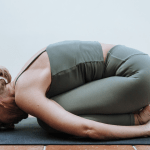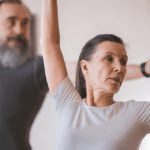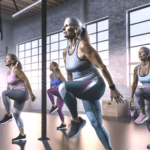Menopause and Exercise
Menopause marks a significant transition in a woman’s life, typically occurring in the late 40s to early 50s. It is defined as the cessation of menstruation for twelve consecutive months. Symptoms vary widely among individuals but can include hot flashes, night sweats, mood swings, weight gain, and sleep disturbances. These changes are primarily due to the decline in the production of hormones such as estrogen and progesterone.
The Link Between Hormonal Changes and Mood
The hormonal fluctuations that accompany menopause can significantly impact mood. Estrogen, in particular, has a modulatory effect on neurotransmitters in the brain, including serotonin and dopamine, which are associated with mood regulation. As estrogen levels decrease, women may experience mood swings, irritability, and increased susceptibility to stress and depression.
The Role of Exercise in Managing Menopause Symptoms
Exercise is a powerful tool for managing the symptoms of menopause. Regular physical activity can help mitigate mood swings, improve sleep quality, and combat weight gain by boosting metabolism. Additionally, exercise is crucial for maintaining bone density and muscle mass, which can decline rapidly during menopause due to hormonal changes.
Personal Anecdote: Seeking a Physical Outlet
As a woman navigating the choppy waters of menopause, I found solace in the rhythmic punches of a boxing workout. The physical exertion was not just a means to maintain fitness; it became a cathartic release for the pent-up frustrations and anxieties that came with my changing body. Each jab and hook empowered me, providing a sense of control in a time of upheaval. This personal journey underscored the profound impact exercise can have on one’s mental and physical well-being during menopause.

From unhappy, dry, and sandpaper to silky, smooth and feeling good. That’s Cleo. Cleo is a 100% natural labial balm to moisture and soothe “your other lips”. Cleo is chemical-free, water-free, pH optimized and helps maintain and restore your delicate labial skin’s natural flora. Ideal for daily use or as needed. Get the most silky, lovable lips ever.
The Psychological Benefits of Physical Activity
Endorphins and Mood Improvement
Physical activity is a well-known mood enhancer, largely due to the release of endorphins, often referred to as “feel-good” hormones. These natural mood lifters are released during exercise, leading to an improved sense of well-being. For menopausal women, who may experience mood swings and increased irritability, the endorphin boost can be particularly beneficial. Regular exercise can help stabilize mood and provide a sense of joy and accomplishment.
Exercise as a Stress Reliever
Menopause can be a stressful time, with hormonal changes often leading to increased anxiety and tension. Exercise serves as a powerful stress reliever, providing a healthy outlet for the frustrations and challenges that come with this life transition. Activities such as yoga, tai chi, or even a brisk walk can help calm the mind, reduce cortisol levels, and alleviate stress, making the menopausal journey more manageable.
Cognitive Function and Mental Clarity
Many women report experiencing “brain fog” during menopause, which can affect memory, concentration, and overall cognitive function. Engaging in regular physical activity has been shown to sharpen mental clarity and improve cognitive function. By increasing blood flow to the brain and encouraging the growth of new brain cells, exercise can help counteract the cognitive decline that some women may face during menopause.
Social Support and Exercise
Exercise can also provide valuable social support, which is crucial during menopause. Joining a fitness class, walking group, or sports team allows for interaction with peers who may be experiencing similar challenges. This camaraderie can lead to increased motivation, accountability, and a sense of belonging, all of which contribute to a more positive outlook during menopause.
In conclusion, the psychological benefits of physical activity during menopause are multifaceted. From the mood-boosting effects of endorphins to the stress-relieving properties of a good workout, exercise is a powerful tool for managing the emotional and cognitive symptoms of menopause. Additionally, the social support gained through group activities can provide a sense of community and encouragement. By incorporating regular physical activity into their routine, menopausal women can enhance their mental well-being and navigate this transition with greater ease and positivity.
Boxing: A Powerful Workout for Menopause
Introduction to Boxing as a Workout
Boxing, traditionally seen as a male-dominated sport, has surged in popularity among women, particularly for those navigating the challenges of menopause. This high-impact, cardio-focused exercise offers a unique blend of muscle toning, fat burning, and strength building. For women in their menopausal years, boxing provides not just a physical workout but also a cathartic release, allowing them to channel their energy and frustrations into each punch.
Physical Benefits of Boxing
Engaging in boxing during menopause can have profound physical benefits. As a vigorous form of cardio, it strengthens the heart muscles and reduces the risk of heart disease, which becomes increasingly important as menopause can elevate this risk. The dynamic movements involved in boxing raise the metabolic rate, aiding in the reduction of menopausal weight gain by replacing fat with muscle. Furthermore, studies suggest that boxing can enhance bone density, combating the onset of osteoporosis—a common concern during menopause. The physical exertion of boxing also leads to improved physical function, helping women feel stronger and more empowered.
Mental and Emotional Release Through Boxing
Menopause can be a rollercoaster of emotions, and boxing serves as an excellent outlet for stress and frustration. The act of hitting a bag allows for a release of pent-up emotions, providing a sense of relief and mental clarity. The production of endorphins during intense physical activity like boxing can elevate mood and create a feeling of well-being. This emotional release is not only therapeutic but also contributes to better mental health, helping to manage the mood swings and anxiety that often accompany menopause.
Safety and Precautions for Beginners
While boxing is an effective workout for menopause, it is crucial to approach it with safety in mind, especially for beginners. Start by choosing a reputable gym or instructor who can guide you through the proper techniques and form. It’s essential to have your wrists wrapped correctly to prevent injury, and to use gloves that provide adequate support and cushioning. Gradually increase the intensity of your workouts to avoid overexertion, and listen to your body’s signals. If you have any pre-existing health conditions or concerns, consult with a healthcare professional before starting a boxing regimen.
In conclusion, boxing is more than just a physical workout; it’s a holistic approach to managing menopause. It offers a range of benefits that address both the physical and emotional challenges of this life stage. With the right precautions and guidance, boxing can be a safe, enjoyable, and incredibly beneficial addition to a menopausal woman’s fitness routine.
Cardiovascular Health and Menopause
Importance of Cardiovascular Exercise
As women transition into menopause, they face a unique set of health challenges, including an increased risk of cardiovascular disease. Cardiovascular exercise becomes paramount during this stage of life, not only for weight management but also for heart health. Engaging in regular aerobic activity helps to improve blood circulation, reduce blood pressure, and manage cholesterol levels. It also contributes to the prevention of arterial diseases that can lead to heart attacks and strokes. For menopausal women, cardiovascular exercise is a key component in maintaining a healthy heart and vascular system.
Managing Cardiovascular Risk Factors
Menopause does not cause cardiovascular disease, but the risk factors associated with heart conditions significantly increase as women age. The decline in estrogen levels during menopause can lead to changes in blood vessel walls and lipid profiles, making it crucial to manage these risk factors through lifestyle choices. Regular cardiovascular exercise helps in managing weight, reducing the risk of type 2 diabetes, and lowering the likelihood of developing high blood pressure. Additionally, it’s important for menopausal women to maintain a balanced diet, avoid smoking, and manage stress to further protect their cardiovascular health.
Types of Cardio Workouts Suitable for Menopause
Finding the right type of cardio workout is essential for menopausal women to ensure consistency and enjoyment. Low-impact activities such as brisk walking, swimming, and cycling are excellent choices that minimize stress on the joints while providing substantial cardiovascular benefits. For those who prefer group settings, dance classes or water aerobics offer a social component that can be motivating. High-intensity interval training (HIIT) can also be adapted for menopausal women, provided they have no contraindications and have built a sufficient fitness base. It’s important to start slowly, listen to the body, and gradually increase intensity to avoid injury. Ultimately, the best cardio workout during menopause is one that fits an individual’s preferences, fitness level, and medical history, ensuring it becomes a sustainable part of their routine.
Strength Training and Bone Health
The Impact of Menopause on Bone Density
Menopause marks a significant change in a woman’s life, and one of the most concerning health risks associated with this transition is the loss of bone density. As estrogen levels naturally decrease during menopause, bones may lose calcium and other minerals at a faster rate, leading to an increased risk of osteoporosis. This condition makes bones more fragile and susceptible to fractures, particularly in the hip, spine, and wrist. It is crucial for menopausal women to understand the importance of maintaining bone health to prevent these potentially debilitating injuries.
Resistance Training for Bone and Muscle Strength
Resistance training, also known as strength training, is a powerful ally in the fight against bone density loss. Engaging in exercises that apply resistance to muscle groups not only builds muscle strength but also stimulates bone formation. This type of training can help counteract the effects of menopause on bone density by increasing bone mass or slowing its loss. The benefits of resistance training extend beyond bone health, as it also aids in maintaining a healthy weight, improving balance, and reducing the risk of falls.
Recommended Strength Exercises
For menopausal women looking to incorporate strength training into their fitness routine, the following exercises are highly recommended:
- Squats: A fundamental exercise that targets the lower body, squats help strengthen the hips, thighs, and buttocks, while also engaging the core.
- Leg Presses: This machine-based exercise allows for targeted strengthening of the legs and glutes, which is essential for supporting the spine and improving overall stability.
- Lat Pulldowns: By working the upper back muscles, lat pulldowns contribute to better posture and upper body strength, which is vital for spine health.
It is important for beginners to start with lighter weights and focus on proper form to avoid injury. Gradually increasing the resistance and complexity of exercises can lead to continuous improvement in bone and muscle strength. Additionally, incorporating a mix of exercises that target different muscle groups can help ensure a well-rounded strength training program.
Menopausal women should consult with a fitness professional or healthcare provider before starting any new exercise regimen, especially if they have existing health concerns. With the right approach, strength training can be a safe and effective way to enhance bone health and overall well-being during menopause.
Creating a Sustainable Exercise Routine
Setting Realistic Goals
Embarking on an exercise journey during menopause requires setting achievable and measurable goals. Start by assessing your current fitness level and consider any physical limitations. Goals should be SMART: Specific, Measurable, Achievable, Relevant, and Time-bound. For instance, aim to walk for 30 minutes a day, five days a week, and gradually increase the intensity or duration over time. Remember, the objective is progress, not perfection.
Incorporating Variety in Workouts
To prevent boredom and plateauing, it’s essential to mix up your workouts. Incorporate different types of exercises such as strength training, cardio, and flexibility workouts like yoga or Pilates. This not only keeps your routine interesting but also ensures that all muscle groups are engaged and different aspects of fitness are addressed. For example, alternate between boxing, swimming, and resistance training throughout the week.
The Importance of Consistency and Enjoyment
Consistency is the key to seeing results, but it’s equally important to enjoy the activities you choose. Select exercises that you look forward to; this could be a dance class, a nature hike, or a Pilates session. Enjoyment fosters consistency, making it easier to stick to your routine. Aim to be active most days of the week, but also listen to your body and allow for rest when needed.
Accountability and Community
Having a support system can greatly enhance your commitment to an exercise routine. Partner up with a friend, join a fitness group, or work with a coach to stay accountable. Sharing your goals with others provides a sense of community and can offer the encouragement needed to stay on track. Additionally, consider using fitness apps or journals to monitor your progress and celebrate your achievements.
Conclusion: Embracing Exercise for Menopause Well-being
Summarizing the Benefits of Exercise During Menopause
As we’ve explored throughout this article, exercise is not just a tool for maintaining physical health; it’s a powerful ally in navigating the menopausal transition. Regular physical activity can help alleviate common menopausal symptoms such as hot flashes, mood swings, and sleep disturbances. It also plays a critical role in managing weight, improving bone density, and reducing the risk of chronic diseases like cardiovascular disease and type 2 diabetes, which can become more prevalent during this stage of life.
Personal Growth and Empowerment Through Fitness
Engaging in regular exercise during menopause is not only about symptom management; it’s a journey of personal growth and empowerment. As women adapt to their changing bodies, fitness can become a source of strength, both literally and figuratively. It’s an opportunity to set new goals, challenge oneself, and celebrate the body’s capabilities, fostering a sense of achievement and confidence that can permeate all areas of life.
Encouragement to Seek Joyful Movement
Exercise should not be a chore; it should be a source of joy and rejuvenation. It’s important to find activities that you genuinely enjoy, whether that’s dancing, hiking, swimming, or practicing yoga. Joyful movement encourages consistency and helps to establish a sustainable routine. It’s also a wonderful way to connect with others, share experiences, and build a supportive community around a shared passion for well-being.
Keeping Menopause in Perspective
Finally, while menopause can be a challenging time, it’s crucial to keep it in perspective. It’s a natural phase of life, not a condition to be feared or fought against. By embracing exercise as a positive force for health and happiness, women can navigate menopause with resilience and grace. The benefits of physical activity extend far beyond the menopausal years, contributing to a vibrant, fulfilling life long after the transition is complete.
In conclusion, exercise is a celebration of what our bodies can do and a testament to our strength as women. It’s an empowering act of self-care that supports not just our physical health, but our emotional and mental well-being too. So, let’s lace up our sneakers, unroll our yoga mats, and hit the trails, embracing every bead of sweat as a badge of honor and every breath as a whisper of perseverance. Together, we can redefine menopause as a time of growth, vitality, and boundless potential.



















